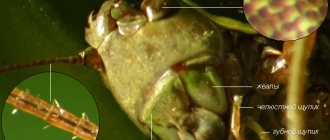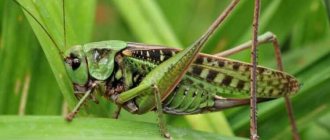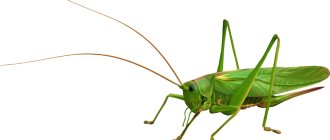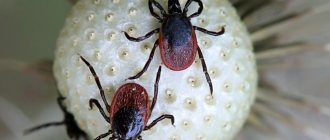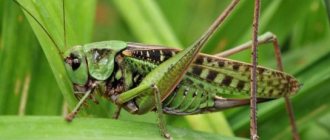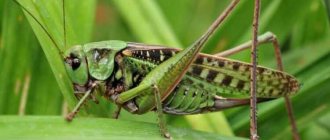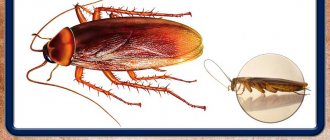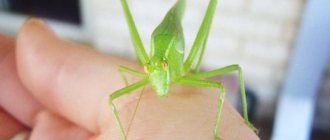Insects of Russia, Forage insects
Today I would like to talk about such a frequently encountered insect as the singing grasshopper; everyone has probably heard the “singing” of grasshoppers thousands of times, this chirping that begins to be heard with the onset of evening and sometimes does not stop until the middle of the night. I am sure that many people know where this chirping comes from - it is a male grasshopper calling for a female. But what else do we know about this insect? Let me tell you about the singing grasshopper in a little more detail.
What does a grasshopper look like?
The color of the insect follows the basic color of the surrounding area. Therefore, it is almost impossible to determine the type of these arthropods by body color.
Even representatives of the same species can have different colors.
Some grasshoppers have a monochromatic body, while others are covered with spots and stripes. Desert inhabitants have a yellowish color, while inhabitants of taiga and tropics have green “camouflage”.
With the help of color, the insect completely blends into the landscape and becomes invisible to predators. In addition, camouflage colors help grasshoppers during hunting. Some species of grasshoppers have even acquired the ability to disguise themselves as other insects using coloring. When threatened, certain species release a liquid with a strong odor.
On average, grasshoppers have a body length of 3-4 centimeters, but some species, especially representatives of South America, grow to large sizes. Grasshoppers have three pairs of legs, with their forelimbs used for calm movement, and their hind limbs used for long jumps. Sometimes the hind limbs may differ in color from the front ones.
The well-known chirping of grasshoppers is carried out using a special sound apparatus located on the elytra. On the right elytra there is a transparent thin membrane, which is surrounded by a vein, creating something like a frame.
On the left elytra there is an opaque formation with dense denticles. While “singing,” the grasshopper spreads its elytra and begins to vibrate, causing the vein with teeth to rub against the membrane frame. This produces a chirping sound.
Each species makes individual sounds. In this case, only males make chirping sounds, while females do not have a sound apparatus. Only rare species of females have such a device.
The hearing aid in grasshoppers is located on the legs; it looks like membranes. This organ consists of nerve endings and sensory cells. The role of touch in grasshoppers is performed by sensitive antennae.
Grasshoppers are “singing” insects.
Insects have a large head, compressed at the sides. The grasshopper has a powerful jaw, which easily bites off food. Females have a long and narrow ovipositor at the bottom of the abdomen, which is shaped like a blade.
Grasshopper nutrition and lifestyle
The diet includes plant foods and other insects. Grasshoppers are natural hunters. They quickly grab the prey with their forelimbs and immediately eat it.
But many species of grasshoppers feed exclusively on plants. Representatives of this family cause damage to agricultural land. But when compared with the damage from other insects, it is not so significant.
In general, grasshoppers are completely harmless insects, whose chirping cannot be confused with anything.
Fat Pallas
The dimensions of this species are 5 cm in females and 6 cm in males. A unique feature of the fat man is that in the process of evolution he completely forgot how to jump.
This makes it defenseless against predators and people who tirelessly conquer the insect’s habitat by plowing the land and grazing livestock.
The colors of these grasshoppers are varied, but variegated individuals are more common. They feed mainly on plant foods; in times of acute shortage, they can also devour their fellow creatures.
Reproduction
Females lay eggs in warm weather. The female plunges the ovipositor into the ground and lays eggs, usually 10-20 pieces, but in some clutches there can be from 1 to 5 eggs.
Grasshoppers are a delicious food for many animals.
The eggs spend the entire winter in the ground, and in the spring they hatch into larvae, which instantly gain weight and constantly molt, thus shedding their old skin. The larva molts up to 5-7 times. As the larvae grow, they develop wings. After the last molt, a sexually mature grasshopper is obtained.
Everyone is familiar with the grasshopper insect.
.
Green and gray grasshoppers
are common among us . These insects live for one year. In the fall they all die, and in the spring a new generation of grasshoppers hatches from overwintered eggs.
Grasshoppers grow slowly. At the beginning of June they reach a length of about half a centimeter. The first, weak, chirping is usually heard at the end of June. Only after they have formed a sound-producing apparatus
, they start booking concerts.
Famous French entomologist Jean Henri Fabre
said that among insects there are no singers, but among them there are many musicians.
The musical apparatus of grasshoppers is located in the elytra
.
The elytra overlap one another, and when the grasshopper moves and spreads them, a chirping sound is heard. Only males chirp
.
Life cycle
The males' nuptial chirping and mating occur in June. The males' singing continues until deep darkness. Males and females mate multiple times. Oviposition occurs in July-August. Females lay eggs in the turf in small groups of 6-8 pieces. In total, one female can lay 48-72 eggs. In nature, embryonic diapause can last more than 3 years. The eggs overwinter. The larvae emerge from the eggs in late April-early May. Larvae of the second and third instars are found in mid-May, the fourth instar - at the end of May. The larvae of the last fifth instar and the first adults are found in early June.
Description of the grasshopper
Here is a description of the grasshopper
.
long thin antennae
on its head
large eyes
on the sides of its head .
The mouth is armed with powerful jaws, with which the grasshopper grabs insects. The grasshopper has three pairs of legs
; large hind legs are used for jumping. During the jump, the wings open and the grasshopper flies. Females have a saber-shaped ovipositor at the end of their abdomen, with which they lay eggs in the soil.
It is interesting that the hearing organs of this insect are located not on the head, but on the front legs, on the lower leg
. You can say that they listen with their feet.
When the grasshoppers chirp
The most energetic chirping of grasshoppers
occurs
in July and August
, when hot, dry weather sets in. In rainy weather they do not chirp. Moreover, before the rain they become silent even on a clear day. As you can see, chirping is greatly influenced by external conditions. By listening to the singing of an insect you can...
The grasshopper insect is a good bait for catching fish. Chub and
Grasshoppers are grasshoppers. It is a superfamily of the order Orthoptera. It has sub-orders. Grasshoppers are classified as long-whiskered. It contains one family of the same name. There used to be more, but the other long-whiskers became extinct.
However, the number of grasshoppers closes the “gaps”. More than 7 thousand species are known. They are divided into genders. Let's look at examples.
Ball-headed grasshoppers
Otherwise called fat people, because they have a fleshy, wide body. The head of insects, as the name implies, is spherical. Its antennae are set below the eyes. Ballheads also have shortened elytra. The hearing organs are located on the front legs. There are cracks visible. These are the ears.
Sevchuk Servilya
This is a medium-sized grasshopper. The two-centimeter body of the insect is dense, wide, and looks short. Painted brown. The flattened pronotum has yellow markings.
The lateral carinae of Serville are pronounced. By the way, the insect was named after an entomologist from France. Guyom Odinet-Servile devoted his life to the study of Orthoptera.
Sevchuk servilla received its name in honor of the French entomologist
Fat guy
European species, on the verge of extinction, included in the species of large grasshoppers
. Males of the species are 8 cm long. The length of females is 6 centimeters.
Names of grasshoppers
often due to their appearance. A fat man, for example, looks plump, even fat. Due to this, the visually black-brown body of the insect appears shorter. Volume is also added by sharp keels on the sides of the grasshopper's pronotum.
Fat grasshopper
Greenhouse grasshoppers
They are hunchbacked and stocky. The body of greenhouse grasshoppers is shortened, but females have a long ovipositor. Representatives of the genus are also distinguished by long legs and mustaches. The latter reach 8 centimeters.
Chinese greenhouse grasshopper
A little less than 2 centimeters in length. The shortened body surrounded by long, thin legs makes the insect look like a spider.
The Chinese grasshopper is painted brown. There are dark spots. They, like the rest of the body, are covered with short, silky hairs. The insect sheds them, along with its chitinous shell, about 10 times during its life. This is a record for grasshoppers.
Far Eastern grasshopper
Included in the grasshopper species of Russia
. The insect is otherwise called a cave insect, since it settles not only in greenhouses, but also in karst rock cavities.
The Far Eastern grasshopper is medium-sized, brown-gray in color. The insect is nocturnal. This distinguishes the species from most grasshoppers.
Habitat
The homeland of the greenhouse grasshopper is East Asia, presumably China. It spread throughout almost the entire globe thanks to trade, namely the plants among which it lived quietly. Since he lived in a warm and tropical environment, he can be found mainly in greenhouses, greenhouses and greenhouses.
It is also found in bathrooms, sewers, bathhouses and basements. For its habitat, it chooses areas with a mild climate, where there is no sharp temperature difference from hot summer to cold winter. It was found in European countries, in the European part of Russia, Belarus, Ukraine, in South and North America.
Dybki
There is one species in the genus. In Russia, its representatives are the largest grasshoppers. The hindquarters are green and have light stripes on the sides. The elongated body reaches a length of 15 centimeters.
Steppe rack
She's a predator. Among grasshoppers there are also herbivores. Predation does not help the steppe to survive. The species is considered endangered.
Steppe bucks have no males. Females use partonogenesis. Eggs are laid and develop without fertilization. Other grasshoppers are not capable of this.
The steppe racket is listed in the Red Book of Insects
Fat Pallas / Deracantha onos
The uniqueness of the species lies in the fact that its representatives, during evolution, have lost the ability to jump. This feature makes this species completely defenseless, especially against human agricultural activities (grazing livestock, land development).
These colorful insects feed mainly on cereals, but cannibalism is possible in captivity.
The sizes of Tolstunov range from 40–50 mm in males to 50–60 mm in females. This species is named after the first scientist who described it, P. Pallas.
3
Field grasshoppers
They have a laterally compressed body with a fusiform and slightly compressed abdomen at the top. Field grasshoppers are also lobed and large-headed, often lack simple eyes and have tightly compressed lips. The jaws of insects of the group are well developed.
Green grasshopper
Cannot be larger than 7 centimeters in length. The insect is painted green. The color on the wings is especially rich. There are 2 pairs of them. This is a feature of all grasshoppers. They use the first narrow pair of wings to protect the body when at rest and when jumping. The upper wings are wide and are used for flight.
On the wings of a green grasshopper there may be brown along the edge. Large eyes stand out on the insect's muzzle. They are faceted, that is, they are held on the head by a ring of cuticle - a tough but flexible tissue.
There are subspecies of green grasshoppers
. They all hide in the crown of bushes and trees. Therefore, insects do not jump out from under people’s feet. Accordingly, meetings with representatives of the group are rare.
song grasshopper
This is a mini copy of a green grasshopper. The songbird does not grow more than 3.5 centimeters. Another 3 may be on the ovipositor.
The wings of the singing grasshopper end level with the abdomen. Representatives of the green species have wings that protrude significantly.
Gray grasshopper
Grows up to 4 centimeters in length. Appearance of a grasshopper
matches the name. The abundance of brown spots on a green background makes the insect gray when viewed from a distance. Gray grasshoppers are easy to see. They live in field and steppe grasses, easily tolerating the heat.
Due to their prevalence and large size, gray grasshoppers are confused with locusts, which belong to the short antennae suborder. In its name lies the difference between insects.
The antennae of the gray grasshopper are often longer than its body. Locusts have short whiskers. The mechanism of chirping also differs. makes sounds by rubbing its paws together. The grasshopper arches its elytra.
Gray one of the most common types of grasshoppers
Long-nosed grasshopper
Represents the fauna of Europe. The length of the insect does not exceed 6.3 centimeters. The color of the grasshopper is brown-green.
The long-nosed insect is named because of the elongated front part of the muzzle. The grasshopper appears to be equipped with a proboscis.
Grasshopper-leaf
In Latin it is called Elimaea Poaefolia. Among field grasshoppers it has the longest body. It is narrow and green. This allows you to blend in with the blades of grass on which the grasshopper sits.
The leaf grasshopper lives in the Malay Archipelago.
Giant weta
Endemic species, found only in New Zealand. The weta weighs about 70 grams, that is, 2 times more than a sparrow. The length of a well-fed grasshopper reaches 15 centimeters. The rest of the appearance is unremarkable. The insect is colored in beige-brown tones.
The legs of the giant weta are of medium length, the eyes are of medium size, and the mustache is of mediocre length in comparison with the size of the body.
The gigantism of New Zealand grasshoppers is due to the absence of small mammals on the islands. For lack of enemies, the Wets almost reached their size. However, in the 20th century, mammals were introduced to the fields of Zealand. Because of this, the number of giant grasshoppers is declining.
Grasshopper giant weta
Flightless grasshoppers
Some grasshoppers lack wings. As a rule, these are inhabitants of fields and rocky embankments. Grasshoppers that climb trees retain their wings. However, there are species with spines on their paws. The needles, like spurs, dig into the stems, fixing insects.
Various colored grasshopper
The name in Latin is opean varicolor. The grasshopper's body is colored white, red and blue. There is an orange-black subspecies. However, this is not the only interesting thing about the grasshopper. The insect lacks wings.
The segmented antennae of opean varicolor are powerful, pointed at the ends, and straight. The hind legs are also powerful. The insect, like all grasshoppers, has 3 pairs of limbs. The species is found in Colombia.
Mormon Grasshopper
A large representative of long antennae, stretches 8 centimeters. Almost half of them in females can occur in the ovipositor.
Mormons are wingless and herbivorous. As a rule, insects settle among legumes and wormwood. Geographically, Mormon grasshoppers gravitate toward the western regions of the North.
Macroxiphus
This grasshopper mimics, that is, takes on the appearance of another creature. We're talking about an ant. By taking on its forms, macroxiphus reduces the number of potential enemies.
The grasshopper in macroxiphus is distinguished by its long hind legs and elongated antennae. Otherwise, the insects are similar to large black ones.
Devil's spiny grasshopper / Panacanthus cuspidatus
This insect with a terrifying name and appearance reaches a length of 60–70 mm.
The grasshopper's body is bright green, and each limb is covered with sharp, most often yellow, spines. In case of danger, the spiny devil rises sharply to its hind limbs, pushing its forelimbs forward. He swings them until the enemy retreats.
Despite its hostility towards enemies, it is quite peaceful and calm, feeding mainly on the seeds of flowering plants.
5
Exotic grasshoppers
There are types of grasshoppers
hardly recognized as such. It's about unusual shapes and colors. Non-standard grasshoppers usually live in the tropics.
Peruvian grasshopper
Opened in 2006 in the mountains of Guyana. The grasshopper imitates the color of a fallen leaf. Externally, the insect also resembles it. The outer side of the folded wings is dotted with a grid pattern. It repeats the capillary pattern on dried greenery.
In order to resemble a fox in shape, the grasshopper folds its wings, covering the sides and a large space above the back.
The underside of the wings of the Peruvian grasshopper is colored like a butterfly eye. She chose this design to scare away predators. Seeing “eyes” on the wings of an insect, they mistake it for a bird or other animal. The Peruvian grasshopper uses the same trick. It also bounces characteristically to resemble the head of a large bird.
The Peruvian grasshopper opens its wings and looks like a butterfly.
Grasshopper rhinoceros
It also resembles a leaf, but green. The color is juicy, closer to light green. The insect's antennae are line-like threads. They are barely noticeable, translucent, significantly longer than the body.
The name of the insect is associated with the presence of a horn-like structure on its head. It is also green, attached to the back of the head, like a leaf stalk.
Spiny Devil
Looking at the types of grasshoppers in the photo
, it's hard not to fix your eyes on the devil. It is emerald in color and covered with triangular needles. They are located all over the body.
The length of the devilish grasshopper does not exceed 7 centimeters, although it is a tropical inhabitant. However, the sharp needles and the insect's manner of waving its limbs in front of its enemies scare away the latter. The devil does this in the forests of the Amazon basin.
Spiny devil grasshopper
Exotic grasshoppers are also found among ordinary ones. Here it is no longer a matter of species, but of genetic anomalies. In the world of grasshoppers, erythrism occurs. This is the absence of pigment. Erythritated grasshoppers resemble albinos, but not the former ones. Pink coloring occurs in one individual out of 500. Erythrism in grasshoppers was discovered in 1987.
Finally, we note that in the eyes of ordinary people, grasshoppers are not only true representatives of the suborder, but also crickets and fillies. The latter have shorter antennae and stockier bodies. Crickets have a spherical head and a flat and short body.
GRASSHOPPER
Nimble grasshopper on the grass
Jumps from end to end.
Fast flying horseshoes
His father gave it to him.
Almost seven thousand species of grasshoppers live on our planet. They live on every continent except Antarctica. Grasshoppers are colored green or brown, which serves as an excellent camouflage for them. They are not at all visible in the thick meadow grass.
Grasshoppers have very powerful, long hind legs. With their help, they can make very long jumps, which will be the envy of other recognized jumpers of the animal world. Grasshoppers jump a distance of 40 times their body length. In Malaysia, there is a grasshopper that is 25 centimeters long and can jump 5 meters!
Grasshoppers are unusual insects. Their hearing organ is on their legs, and they rattle... with their wings. Each type of grasshopper chirps differently. As a rule, only males can chirp, but there are species in which females also chirp.
Some grasshoppers feed on plant foods - they eat grape leaves, flowers and buds, they love tea bushes and citrus plants. Other types of grasshoppers feed on small insects - flies, small butterflies and their caterpillars.
In summer, the female grasshopper lays 70–100 eggs in the ground. In the spring, the larvae hatch from them. They are green in color with a brown or blackish stripe on the back.
In our country, the most common grasshopper is the green one. The steppe part of Russia is home to the steppe grasshopper, one of the largest grasshoppers. The length of its body reaches 6–8 cm. In its habits, the steppe rack is more reminiscent of a praying mantis. She can sit motionless in the grass for hours waiting for prey, which she catches with her front legs. The rack feeds on large insects - locusts, crickets, beetles and bedbugs.
The warty grasshopper got its name because it was used to remove warts. The grasshopper was forced to bite a wart and secrete healing saliva onto it.
MYSTERY
This little violinist
Emerald wears a cloak.
He is also a champion in sports,
He can jump deftly.
There is probably not a single person on earth who has not heard the chirping of a grasshopper at least once in his life.
Even kids can distinguish the peculiar sound of a grasshopper from other insects.
What does the singing grasshopper eat:
The singing grasshopper has a mixed diet, that is, it can eat both plant and animal (insects) food. During the day, sitting on a branch or in the grass, the singing grasshopper very cleverly catches small insects and eats them with pleasure. By the way, it is worth noting that the jaws of the singing grasshopper are quite strong and can bite through human skin.
Structure
External characteristics of the grasshopper:
- Body flattened on both sides;
- Head with large eyes;
- 3 pairs of legs;
- Wings.
They move with the help of their front legs, and with the help of their more muscular hind legs, insects jump quite long distances. The length of the jump is 20 times greater than the insect's body.
The length of a grasshopper depends on the species and ranges from 1 to 5 cm, but there are some individuals whose size reaches 15 cm. Which is comparable to the length of a praying mantis.
The whiskers serve as the insect's sense of touch. An interesting fact is that the longer the length of the antennae, the higher the higher place the grasshopper occupies on the hierarchical ladder among its relatives.
The wings have a direct function and help the grasshopper take off and fly short distances.
Some subspecies have an additional pair of wings that perform a protective or safety function for the main wings.
Lots of questions
Indeed, I would like at least some specific words from experts about whether this fact actually took place. There is only an old photograph in which the largest grasshopper (photo attached) hangs lifelessly with its antennae down, its hind legs (although in relation to the photograph one should say antennae and paws) are doubtfully clamped by the frail hand of a brave hunter. If this fact took place, then where was the public looking? Did the Red Book appear after this incident? There are more questions than answers. The photo looks like an obvious hoax - Americans are generally known forgers. Every criticism is valid. Indeed, where is the shadow of the grasshopper? Why is the posture of a successful hunter so relaxed, because the load is considerable? Someone even pointed out the fact that in 1937 “baseball caps” were not worn. As for the size, there are clear facts that they do not correspond to the life of this type of insect.
Grasshopper chirping
Any type of grasshopper has a peculiar chirping sound, but in most cases this sound is made by males.
Only in some types of grasshoppers are females capable of producing musical sounds, because the wings of females are much weaker than those of the opposite sex.
Due to this feature, females are simply not able to produce such a musical and expressive sound.
The basic wings with which the insect takes off have hard elytra. In this case, one wing acts as a resonator, and the second acts as a bow.
Due to the vibration of the wings, a wonderful chirping sound is created, which is characteristic of a certain type of grasshopper.
Grasshopper color
The color of the insect will depend on the habitat in which it lives. That is why you can find green, brown and even striped colors.
One of the characteristics of the grasshopper is the location of its ears. They did not have enough space on their heads, like many representatives of other insects. Therefore, the ears are located on the front legs in the area of the lower leg.
In the same place are the eardrums, which perform their direct function. When the front legs are lost, hearing is correspondingly lost. Legs are especially precious to him.
Giant Weta
You can meet this giant on the islands of New Zealand. It was the isolation of the territories that allowed the insect to grow to its modern size.
Endemics are often distinguished by gigantism; it will not be possible to meet this grasshopper in any other place except the New Zealand archipelago.
The color of the insect is brown, its dimensions reach 10 cm in length, its legs are equipped with sharp spines, which the insect uses exclusively for defense.
How does a grasshopper live?
The lifestyle directly depends on the type of grasshopper and its characteristic features.
A common green grasshopper has a body length of up to 4 mm. This is believed to be the most common group.
As for orange grasshoppers, they were brought to us from China. You can only see them in greenhouses.
The largest grasshopper is considered to be the Giant Weta. It weighs about 80 grams.
Grasshoppers are not pests for humans and agricultural land. And some peoples have long included these insects in their daily diet.
If a grasshopper feels threatened by a person, it may bite him. The bites received from this insect are quite painful, because it has a powerful jaw.
Some people like the grasshopper's singing, and in order to continue to listen to it constantly, people have come up with an artificial habitat for maintaining a home - insectariums.
Home maintenance
Many people may think that the singing grasshopper is an excellent pet to keep at home, but actually they are right. If you are not bothered by the fact that the pet will not live long, and will chirp without a female in a pair, then feel free to drag it home.
It is not difficult to make a terrarium for a singing grasshopper; any container with sufficient ventilation, approximately 40x30x30 in size for 2-3 singing grasshoppers, will do.
It is recommended to sprinkle sawdust at the bottom of the container, and place a jar of wet peat in the corner, into which the female will lay larvae. Any substrate will do, even soil from the street, with the proviso that you will then have to look for the eggs of the singing grasshopper by hand. You should also place various driftwood and sticks in the container to increase the usable area and allow the grasshopper to climb branches.
The singing grasshopper should be fed with insects; at home, you can feed it with food insects such as marbled or Turkmen cockroaches; you should also offer greens, in the form of various plants from the street.
Song grasshopper eggs along with the substrate should be removed at the end of August and placed in the refrigerator until the end of February. Then they are removed and the little singing grasshoppers are waited for to emerge.
Control measures
Methods to combat this insect have not yet been sufficiently developed. For preventive and exterminatory purposes, the following is recommended: it is advisable to locate tobacco plantations away from egg-laying sites (thrush and virgin areas) of the green grasshopper; treatment of the shag field and surrounding area with internal poisons; placement of bait with poison in pest habitats. This will require 30–60 kg of bran, 24 liters of water, 0.8–1.2 kg of arsenous soda.
Video
Reproduction
The beginning of reproduction depends on the habitat. In temperate climates, lovemaking begins in late spring or early summer. At this time, the males emit loud trills.
At this point, they have seminal fluid in the form of a capsule, which is necessary for reproduction.
At the moment of reproduction, the male attaches a sticky bait - a capsule - to the female's abdomen. While she eats it, the liquid gradually enters her oviduct.
After fertilization, the female lays eggs on her own, which can contain from 100 to 1000 eggs. Then larvae appear, resembling a small grasshopper.
During growth, the grasshopper molts from 4 to 8 times. After the last molt, the insect waits until its wings get stronger. The insect lives only one season.

